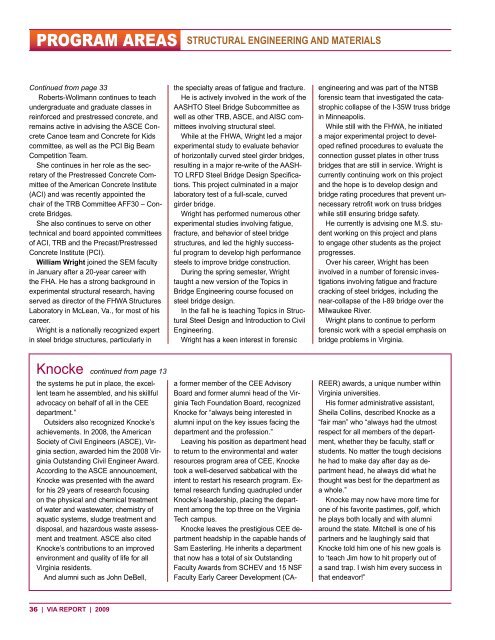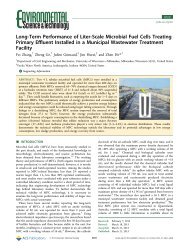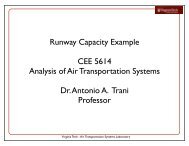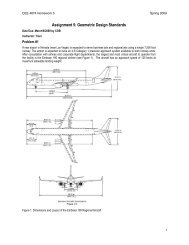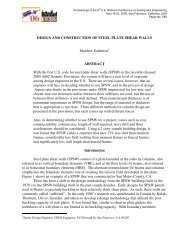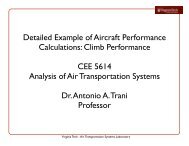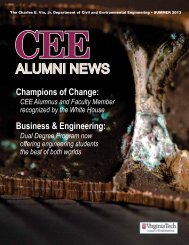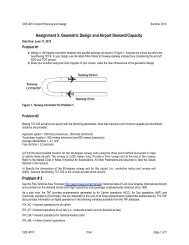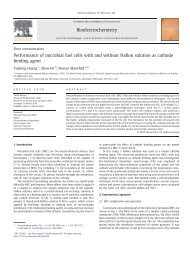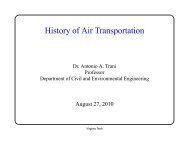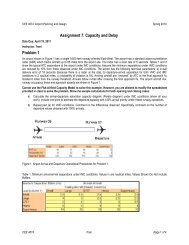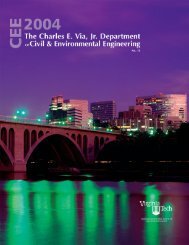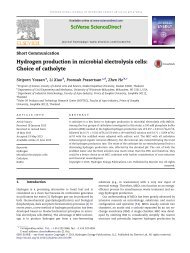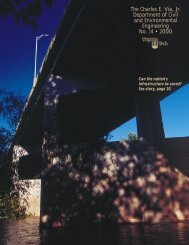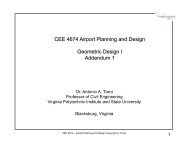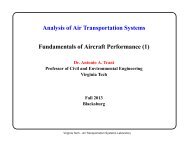Annual Report Year 2009 - Civil and Environmental Engineering
Annual Report Year 2009 - Civil and Environmental Engineering
Annual Report Year 2009 - Civil and Environmental Engineering
- No tags were found...
Create successful ePaper yourself
Turn your PDF publications into a flip-book with our unique Google optimized e-Paper software.
PROGRAM AREAS<br />
STRUCTURAL ENGINEERING AND MATERIALS<br />
Continued from page 33<br />
Roberts-Wollmann continues to teach<br />
undergraduate <strong>and</strong> graduate classes in<br />
reinforced <strong>and</strong> prestressed concrete, <strong>and</strong><br />
remains active in advising the ASCE Concrete<br />
Canoe team <strong>and</strong> Concrete for Kids<br />
committee, as well as the PCI Big Beam<br />
Competition Team.<br />
She continues in her role as the secretary<br />
of the Prestressed Concrete Committee<br />
of the American Concrete Institute<br />
(ACI) <strong>and</strong> was recently appointed the<br />
chair of the TRB Committee AFF30 – Concrete<br />
Bridges.<br />
She also continues to serve on other<br />
technical <strong>and</strong> board appointed committees<br />
of ACI, TRB <strong>and</strong> the Precast/Prestressed<br />
Concrete Institute (PCI).<br />
William Wright joined the SEM faculty<br />
in January after a 20-year career with<br />
the FHA. He has a strong background in<br />
experimental structural research, having<br />
served as director of the FHWA Structures<br />
Laboratory in McLean, Va., for most of his<br />
career.<br />
Wright is a nationally recognized expert<br />
in steel bridge structures, particularly in<br />
the specialty areas of fatigue <strong>and</strong> fracture.<br />
He is actively involved in the work of the<br />
AASHTO Steel Bridge Subcommittee as<br />
well as other TRB, ASCE, <strong>and</strong> AISC committees<br />
involving structural steel.<br />
While at the FHWA, Wright led a major<br />
experimental study to evaluate behavior<br />
of horizontally curved steel girder bridges,<br />
resulting in a major re-write of the AASH-<br />
TO LRFD Steel Bridge Design Specifications.<br />
This project culminated in a major<br />
laboratory test of a full-scale, curved<br />
girder bridge.<br />
Wright has performed numerous other<br />
experimental studies involving fatigue,<br />
fracture, <strong>and</strong> behavior of steel bridge<br />
structures, <strong>and</strong> led the highly successful<br />
program to develop high performance<br />
steels to improve bridge construction.<br />
During the spring semester, Wright<br />
taught a new version of the Topics in<br />
Bridge <strong>Engineering</strong> course focused on<br />
steel bridge design.<br />
In the fall he is teaching Topics in Structural<br />
Steel Design <strong>and</strong> Introduction to <strong>Civil</strong><br />
<strong>Engineering</strong>.<br />
Wright has a keen interest in forensic<br />
engineering <strong>and</strong> was part of the NTSB<br />
forensic team that investigated the catastrophic<br />
collapse of the I-35W truss bridge<br />
in Minneapolis.<br />
While still with the FHWA, he initiated<br />
a major experimental project to developed<br />
refined procedures to evaluate the<br />
connection gusset plates in other truss<br />
bridges that are still in service. Wright is<br />
currently continuing work on this project<br />
<strong>and</strong> the hope is to develop design <strong>and</strong><br />
bridge rating procedures that prevent unnecessary<br />
retrofit work on truss bridges<br />
while still ensuring bridge safety.<br />
He currently is advising one M.S. student<br />
working on this project <strong>and</strong> plans<br />
to engage other students as the project<br />
progresses.<br />
Over his career, Wright has been<br />
involved in a number of forensic investigations<br />
involving fatigue <strong>and</strong> fracture<br />
cracking of steel bridges, including the<br />
near-collapse of the I-89 bridge over the<br />
Milwaukee River.<br />
Wright plans to continue to perform<br />
forensic work with a special emphasis on<br />
bridge problems in Virginia.<br />
Knocke continued from page 13<br />
the systems he put in place, the excellent<br />
team he assembled, <strong>and</strong> his skillful<br />
advocacy on behalf of all in the CEE<br />
department.”<br />
Outsiders also recognized Knocke’s<br />
achievements. In 2008, the American<br />
Society of <strong>Civil</strong> Engineers (ASCE), Virginia<br />
section, awarded him the 2008 Virginia<br />
Outst<strong>and</strong>ing <strong>Civil</strong> Engineer Award.<br />
According to the ASCE announcement,<br />
Knocke was presented with the award<br />
for his 29 years of research focusing<br />
on the physical <strong>and</strong> chemical treatment<br />
of water <strong>and</strong> wastewater, chemistry of<br />
aquatic systems, sludge treatment <strong>and</strong><br />
disposal, <strong>and</strong> hazardous waste assessment<br />
<strong>and</strong> treatment. ASCE also cited<br />
Knocke’s contributions to an improved<br />
environment <strong>and</strong> quality of life for all<br />
Virginia residents.<br />
And alumni such as John DeBell,<br />
a former member of the CEE Advisory<br />
Board <strong>and</strong> former alumni head of the Virginia<br />
Tech Foundation Board, recognized<br />
Knocke for “always being interested in<br />
alumni input on the key issues facing the<br />
department <strong>and</strong> the profession.”<br />
Leaving his position as department head<br />
to return to the environmental <strong>and</strong> water<br />
resources program area of CEE, Knocke<br />
took a well-deserved sabbatical with the<br />
intent to restart his research program. External<br />
research funding quadrupled under<br />
Knocke’s leadership, placing the department<br />
among the top three on the Virginia<br />
Tech campus.<br />
Knocke leaves the prestigious CEE department<br />
headship in the capable h<strong>and</strong>s of<br />
Sam Easterling. He inherits a department<br />
that now has a total of six Outst<strong>and</strong>ing<br />
Faculty Awards from SCHEV <strong>and</strong> 15 NSF<br />
Faculty Early Career Development (CA-<br />
REER) awards, a unique number within<br />
Virginia universities.<br />
His former administrative assistant,<br />
Sheila Collins, described Knocke as a<br />
“fair man” who “always had the utmost<br />
respect for all members of the department,<br />
whether they be faculty, staff or<br />
students. No matter the tough decisions<br />
he had to make day after day as department<br />
head, he always did what he<br />
thought was best for the department as<br />
a whole.”<br />
Knocke may now have more time for<br />
one of his favorite pastimes, golf, which<br />
he plays both locally <strong>and</strong> with alumni<br />
around the state. Mitchell is one of his<br />
partners <strong>and</strong> he laughingly said that<br />
Knocke told him one of his new goals is<br />
to ‘teach Jim how to hit properly out of<br />
a s<strong>and</strong> trap. I wish him every success in<br />
that endeavor!”<br />
36 | VIA REPORT | <strong>2009</strong>


